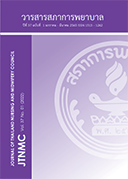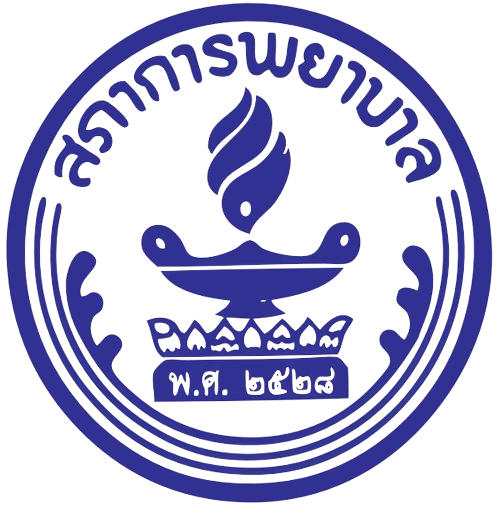Health Literacy Development Model to Promote Self-Management Behaviours and Its Health Impact on Older Adults with Both Type 2 Diabetes and Hypertension, in Primary Care Clusters in Saraburi Province
Keywords:
health literacy, older adults with both type 2 diabetes and hypertension, self-management behaviours, health impact, HbA1c, blood pressureAbstract
Objective: To study the efficacy of a health literacy development model in promotion of self-management behaviours amongst older adults with type 2 diabetes and hypertension
Design: Research and development
Methodology: The research was conducted in four stages: 1) studying and analysing concepts, research studies, and current situation pertaining to health literacy and self-management amongst diabetic older adults with hypertension; 2) developing a model for health literacy and self-management for diabetic older adults with hypertension; 3) conducting analysis of the outcomes, namely, self-management behaviours, HbA1c, and blood pressure in 150 older adults with type 2 diabetes and hypertension; and 4) making post-experimental improvements. Data were collected from January 2020 to March 2021. The quantitative data were analysed with focus on percentage, mean, standard deviation, and independent T-test. Analysis of the qualitative data was conducted using content analysis.
Results:
1. The health literacy development model aimed to promote five major qualities: 1) confidence in making a change; 2) proper approach to and understanding of the disease; 3) health-related communication and decision-making; 4) self-determined direction of change; and 5) continued practice for positive health outcomes.
2. Regarding the effcacy of the model, it was found that after the intervention, the experimental group’s average self-management behaviour score was signifcantly higher than that of the control group, (p < 0.001). The experimental group’s average HbA1c and systolic blood pressure levels were signifcantly lower than those of the control group (p < 0.01 and p < 0.001, respectively). The experimental group’s average systolic blood pressure level was also lower than that of the control group, but without any statistical signifcance.
Recommendations: The findings of this study can be applied to improving the health literacy of older adults with type 2 diabetes and hypertension, for the purpose of promoting self-management behaviours as well as regulating their HbA1c and blood pressure.
Downloads
References
World Health Organization. Global report on diabetes. 2016. https://www.who.int/diabetes/global-report/en/
Aekplakor W. Report of the survey of the Thai people by physical examination 5th, 2014. 2016 Health System Research Institute (HSRI). (in Thai)
Department of Disease Control Division of Non Communicable disease. Annual Report Bureau of Non Communicable disease. 2017. (in Thai)
Yandrapalli S, Pal S, Nabors C, Aronow WS. Drug treatment of hypertension in older patients with diabetes mellitus. Expert Opinin Pharmacother 2018; 19 (7): 633–42.
Akalu Y, Belsti Y. Hypertension and its associated factors among type 2 diabetes mellitus patients at debre tabor general hospital, Northwest Ethiopia. Diabetes Metab Syndr Obes 2020; 13: 1621–31.
Department of Disease Control Division of non communicable disease strategy and planning group. 5-Year National NCDs Prevention and Control Strategic and Action Plan (2017-2021). 2017. (in Thai)
Hfocus news agency delves into health systems. 11th National Health Assembly ‘12-14 December’ prevent disease in age of 4.0 NCC. Know about health. 2018. (in Thai)
Sørensen K, Van den Broucke S, Fullam J, Doyle G, Pelikan J, Slonska Z, et al. Health literacy and public health: a systematic review and integration of defnitions and models. BMC Public Health 2012; 12: 80.
Nutbeam D. Defning, measuring and improving health literacy. 2015, January 7. https://www.jstage. jst.go.jp/article/jhep/42/4/42_450/_pdf/-char/ja
Bailey SC, Brega AG, Crutchfeld TM, Elasy T, Herr H, Kaphingst K, et al. Update on health literacy and diabetes. Diabetes Educ 2014; 40(5): 581–604. doi:10.1177/0145721714540220
Dahal PK, Hosseinzadeh H. Association of health literacy and diabetes self-management: a systematic review. Aust J of Prim 2019; 25: 526–33. https://doi.org/10.1071/PY19007
Jaisit J, Meetam R, Kamkan P. Effect of self-management supporting program on self-management behaviors and hemoglobin A1C level among persons with type 2 diabetes. Journal of Nursing Science & Health; 40(2): 65-73. (in Thai)
Chrvala CA, Sherr D, Lipman RD. Diabetes self-management education for adults with type 2 diabetes mellitus: a systematic review of the effect on glycemic control. Patient Educ Couns 2017; 99: 926–43.
Lee E.-H, Lee, YW, Lee K.-W, Nam M, Kim SH. A new comprehensive diabetes health literacy scale: development and psychometric evaluation. Int J Nurs Stud 2018; 88: 1–8. https://doi.org/10.1016/j.ijnurstu.2018.08.002
Pannark P, Moolsart S, Kaewprom C.The effectiveness of a program for health literacy development of the patients with uncontrolled type 2 diabetes at Bangwua District Chachoengsao Province. Nursing Journal of the Ministry of Public Health 2017; 27(3): 92-106. (in Thai)
Wang L, Fang H, Xia Q, Liu X, Chen Y, Zhou P, et al. Health literacy and exercise-focused interventions on clinical measurements in Chinese diabetes patients: A cluster randomized controlled trial. EClinical Medicine 2019; 17, Article 100211. https://doi.org/10.1016/j.eclinm.2019.11.004
Kim SH, Lee A.Health-literacy-sensitive diabetes self-management interventions: a systematic review and meta-analysis. Worldviews Evid Based Nurs 2016; 13(4):324–33.
Dunn P, Conard S. Improving health literacy in patients with chronic conditions: a call to action. Int J Cardiol 2018; 273: 249–51.
Miller WR, Rollnick S. Motivational interview helping people change (3rd Ed.). London: Guilford press; 2012.
Prommanee P, Eamsa-ad S, Grasung P. Guideline to construct and development model for public health operations for public health offcer. Association of Private Higher Education Institutions of Thailand Journal 2017; 6(2):128-135. (in Thai)
Lorini, C., Lastrucci, V., Mantwill, S., Vettori, V., & Bonaccorsi, G., Measuring health literacy in Italy: a validation study of the HLS-EU-Q16 and of the HLS-EU-Q6 in Italian language, conducted in Florence and its surroundings. Annali dell’Istituto Superiore di Sanità, 2019; 55(1): 10–18.
Toobert DJ, Sarah EH, Glasgow RE. The summary of diabetes self-care activities measure. Diabetes Care 2000; 23(7): 943-50.
Faul F, Erdfelder E, Lang, AG, Buchuer A. G* power 3: A flexible statistical power analysis program for the social, behavioral, and biomedical sciences. Behav Res Methods 2007; 39(2): 175-91.
Thepwongsa I, Muthukumar R, Kessomboon P. Motivational interviewing by general practitioners for type 2 diabetes patients: a systematic review. Fam Pract 2017; 34(4): 376–83.
Hong YR, Jo A, Cardel M, Huo J, Mainous AG. Patient-provider communication with teach-back, patient-centered diabetes care, and diabetes care education. Patient Educ Couns 2020; 103: 2443–50.
Hong YR, Huo J, Jo A, Cardel M, Mainous AG. Association of patient-provider teach-back communication with diabetic outcomes: a cohort study. J Am Board Fam Med 2020; 33(6):903-12.
Inoue M, Takahashi M, Kai I. Impact of communicative and critical health literacy on understanding of diabetes care and self-effcacy in diabetes management: across-sectional study of primary care in Japan. BMC Fam Pract 2013; 14: 40. http://www.biomedcentral.com/1471-2296/14/40.
Wallace AS, Perkhounkova Y, Sussman AL, Hein M, Chung SJ, Tripp-Reimer T. Implementation of collaborative goal setting for diabetes in community primary care. Transl Behav Med 2016; 6 (2): 202–11. doi: 10.1007/s13142-016-0389-5
Miller CK, Bauman J. Goal-setting: An integral component of effective diabetes care. Curr Diab Rep 2014; 14(8): 1–8. doi:10.1007/s11892-014-0509-x
Soliman HMM, Mohamed WG. Educational intervention and tele-nursing effects on glycemic control, metabolic parameters and adherence in adults with type II diabetes mellitus. IJND 2016; 6(2) http://dx.doi.org/10.15520/ijnd.2016.vol6.iss2.130.01-11
Borhani F, Lashkari T, Sabzevari S, Abbaszadeh A. Effect of telenursing (telephone follow-up) on glycemic control and body mass index (BMI) of type 2 diabetes patients. Iran J Nurs Midwifery Res 2013; 18(6): 451–6.
Downloads
Published
How to Cite
Issue
Section
License
Copyright (c) 2022 Thai Journal of Nursing Council

This work is licensed under a Creative Commons Attribution-NonCommercial-NoDerivatives 4.0 International License.








